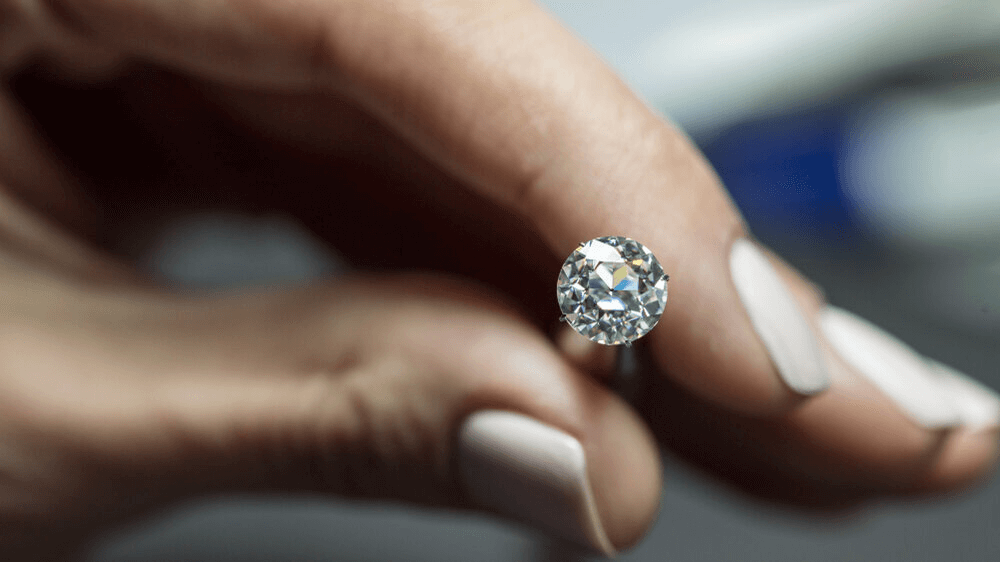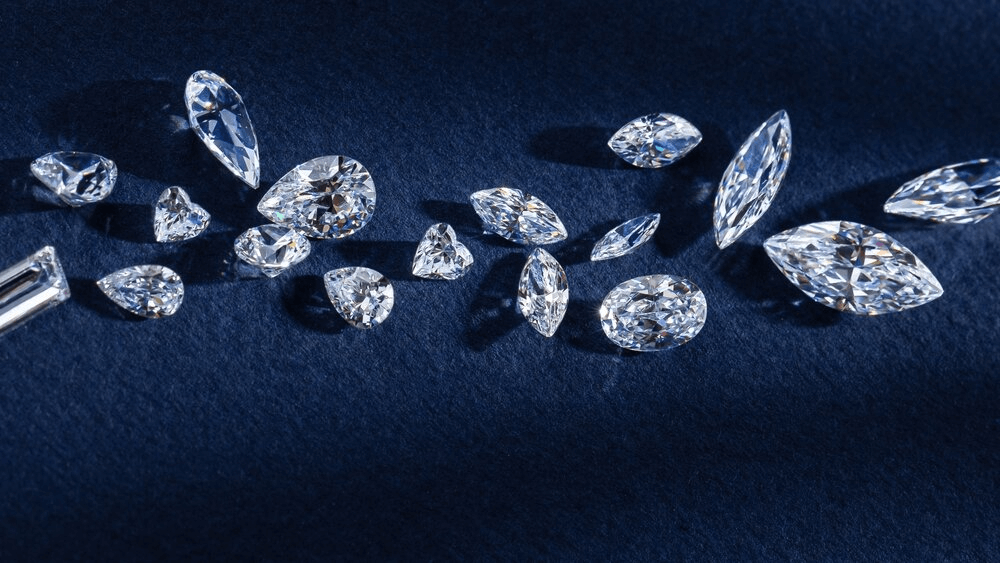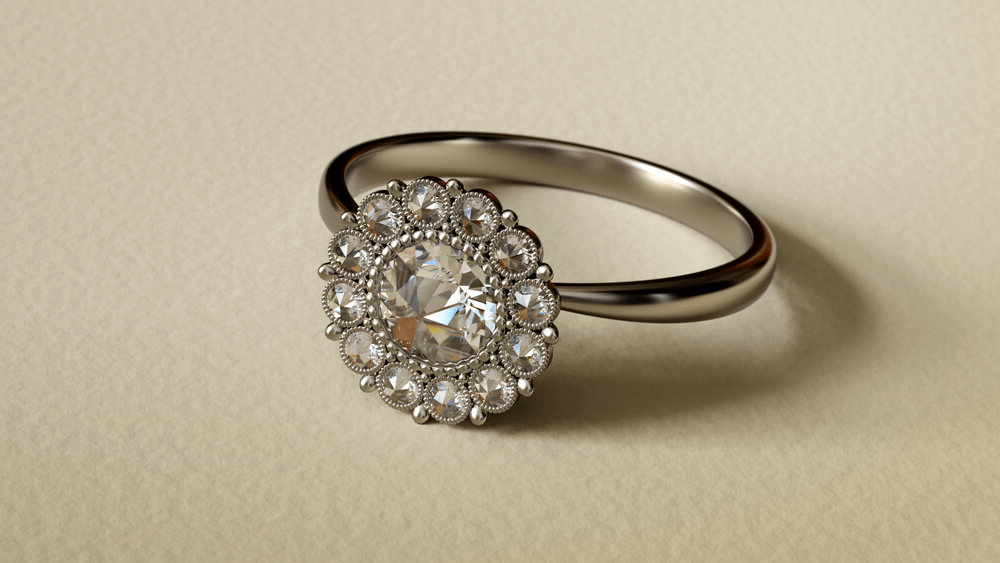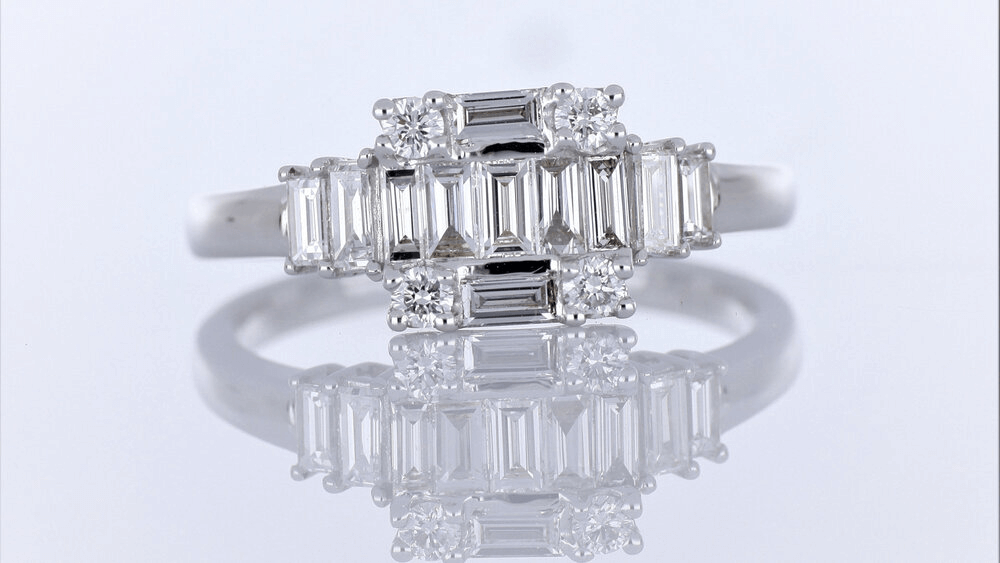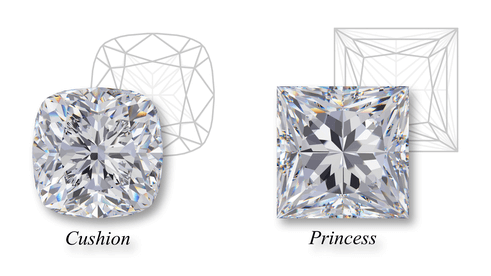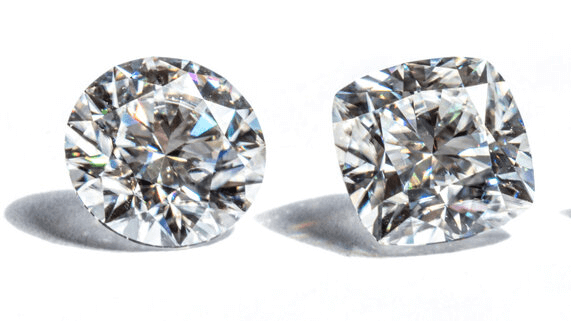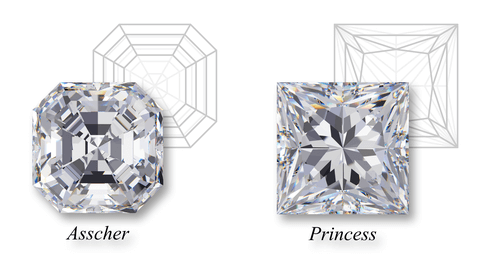Princess cut vs. Round cut Diamonds: The Debate Ends Here

By Gary A.

Edited by Olivia H.
Published Jul 26, 2022
Edited on Dec 18, 2024
When it comes to choosing the perfect engagement ring, the debate between Princess cut and Round cut diamonds often comes down to personal style and sparkle preferences.

- 7 Quick Tips for Choosing Between Princess Cut and Round Cut Diamonds for an Engagement Ring
- Introduction: Princess Cut vs. Round Diamonds
- Analyzing Sparkle and Brilliance
- Versatility in Design and Style
- Cost Comparison: Budget-Friendly Options
- Size Perception
- The Color and Clarity Factor
- Comfort
- Our Expert Take
- 10 FAQs
Before we dive deeper into the specifics, here are some practical tips to help guide your decision-making process:
7 Quick Tips for Choosing Between Princess Cut and Round Cut Diamonds for an Engagement Ring
When selecting a diamond engagement ring, particularly when deciding between princess cut and round cut diamonds, there are several crucial aspects to consider. Here are practical tips to guide you through the process:
- Tip 1: Understand the Visual Impact: Princess Cut: Known for its sharp, angular lines and modern look. It offers a distinctive sparkle that is slightly less traditional than the round cut. Round Cut: Classic and versatile, providing maximum brilliance and fire. It’s the most popular choice for engagement rings due to its timeless appeal and the way it maximizes light reflection.
- Tip 2: Assess the Setting and Durability: Princess Cut: Requires a protective setting to safeguard its pointed corners from chipping, particularly important if the wearer leads an active lifestyle. Round Cut: More forgiving in various settings, with no sharp edges, making it a more durable choice for daily wear.
- Tip 3: Compare Size Appearance and Cost: Princess Cut: Generally offers more carat weight for the same surface area, making it a cost-effective choice. However, it may appear smaller than a round diamond of the same carat due to its cut. Round Cut: Although typically more expensive, it often appears larger due to its cut and facet arrangement, providing a better size appearance for the same carat weight.
- Tip 4: Examine Color and Clarity: Princess Cut: Can sometimes show more color than round diamonds, so a higher color grade might be necessary to maintain a clear appearance. Round Cut: Superior in masking color and inclusions, allowing for a bit more flexibility in choosing lower color and clarity grades without compromising the diamond’s appearance.
- Tip 5: Consider Personal Style Preferences: Princess Cut: Appeals to those seeking a contemporary and bold look. It’s ideal for someone who wants a mix of tradition and modernity. Round Cut: Best suited for individuals who prefer classic elegance and timeless design. It’s a safe choice for those uncertain about specific style preferences.
- Tip 6: Think About Resale Value and Popularity: Princess Cut: While stylish, may not have the same universal appeal as round diamonds, potentially affecting its resale value. Round Cut: High demand and popularity often mean better resale value, making it a more secure investment in the long term.
- Tip 7: Analyze Light Performance and Sparkle: Princess Cut: Offers a unique sparkle, but it may not achieve the same level of brilliance as a round cut. Round Cut: Engineered for optimal light performance, resulting in unmatched brilliance and sparkle, which is a key factor for many when choosing an engagement ring.
Now that you’ve got these practical tips, use Jeweler AI below to find the perfect engagement ring that suits your style and budget:
Introduction: Princess Cut vs. Round Diamonds
For so many people, the Round Brilliant diamond shape is the first to come to mind when they start planning to pop the question. While other, modified brilliants – the Princess included – are indisputably beautiful, eye-catching, and impressive, the Round Brilliant is basically the ‘headline act’ of the engagement ring world. Even hearing the phrase ’engagement ring’ conjures up an image of that classic Round Brilliant solitaire.
But, while it might be the most obvious option for proposing, that’s not to say that it’ll be the one everyone lands on. Sure, the Round Brilliant might have the house advantage (in what ways, we’ll get into below), but a shape like the Princess brings so much to the table that some of us just can’t resist.
So, if you’ve found yourself caught-up somewhere between the two, here’s our full, impartial run-through of the Princess cut vs Round cut.
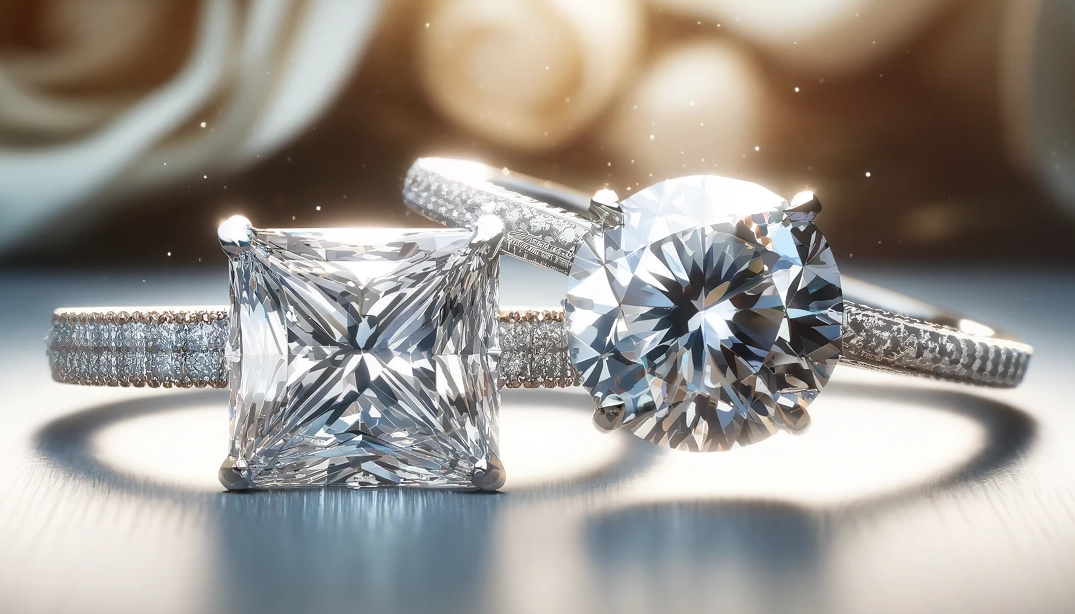
Analyzing Sparkle and Brilliance
The Round Brilliant
The Round diamond cut is a classic, and a sparkly one at that. It offers an incredible light performance and a very versatile and durable shape that will go with virtually any ring design.
The Princess
The Princess is a beautiful, contemporary diamond shape. It’s got a distinctive pattern visible through the table thanks to its unique shape and facet pattern, and a great sparkle.
Even if you only know a little about diamonds, you’ll probably already know that the Round Brilliant is the most sparkly of all the shapes. Perfected over a hundred years ago, the Round Brilliant shape was purposefully designed to optimize the way light travels in, through, and back out of the diamond. The symmetricity and even proportions of the shape, along with the precise size, number, and position of the facets, mean that you won’t get more sparkle out of any other shape.
As always, the power of a Round diamond’s sparkle is totally dependent on the quality of the cut itself. A poorly cut Round Brilliant won’t be very brilliant at all, so prioritizing a high cut grade (never below ‘Very Good’ on the GIA scale), along with good proportions, symmetry and polish is absolutely essential.
Brilliance in Round Diamonds
As the name suggests, the Round Brilliant produces a lot of brilliance – the white flashes of light that flit across the diamond’s crown and table when the light hits – but they also produce plenty of fire, too. Fire is the colorful light created across a diamond’s surface. A good mix of brilliance and fire is what a lot of shoppers are looking for, although some shapes produce more of one than the other. The Emerald cuttends to create more brilliance (in bigger flashes than shapes like the Round), while the Cushion cut tends to create a lot more fire than brilliance.
Unique Sparkle of Princess Cut Diamonds
The Princess cut also creates an excellent mix of brilliance and fire and, provided the cut quality is good, it is generally considered to inhabit ‘second place’ behind the Round Brilliant for sparkle. Its unique facet pattern creates a very attractive, pixelated pattern visible through the table – something that gives it a very modern, sophisticated look.
Versatility in Design and Style
Every shape is versatile to some extent, but a few offer more design options than others…
Round Diamonds: A Timeless Choice
The Round Brilliant would not have grown as popular and timeless as it has if it weren’t for its versatility. The shape lends itself to any ring style imaginable, from the very simple – again, don’t rule out the sheer power of a beautiful solitaire – to something a lot more complex and ornate. It can work in a very modern setting, like a streamlined platinum tension ring setting, or it can look just as convincing in a vintage-inspired ring design.
The Round cut diamond also looks great in a halo. For a twist, you could consider pairing a round diamond with a square halo – excellent if you love the silhouette created by the Princess cut but still want to get maximum sparkle out of your diamond.
For three stone engagement rings, consider pairing a Round Brilliant with a north-south baguette cut on either side (for contrast), or two smaller Pear cut diamonds positioned East-West, like petals shooting off a flower.
Princess Cut: Modern and Bold
The Princess is almost as versatile, although it’s not quite so suited to vintage-style engagement rings. The cut was created in the 1980s, and while its relative newness doesn’t stop it from working with all sorts of ring designs, its distinctly modern look can slightly limit shoppers.
Of course, if you’re drawn to the Princess cut in the first place, there’s a good chance you’re already thinking of a more contemporary ring design for your partner.
Another thing to consider about the Princess cut is how to keep it safe within its setting. The Round cut does not feature any sharp edges or corners that make the stone vulnerable to chipping, but the Princess cut does. Its four precise corners come to very fine points, which does represent something of a risk when the diamond is worn daily on the finger. It’s perfectly possible to keep them safe with prongs or a more protective setting, like a halo or bezel, but that means you’re a little more limited in terms of design choices.
Then again, the Princess gives so much versatility to pairing it with other accents and design features that you won’t feel stuck on what to do with your diamond.
Cost Comparison: Budget-Friendly Options
We often recommend you are guided by what you know about your partner’s sense of style and taste more than anything else. A diamond engagement ring will always be expensive, so going off the numbers alone probably isn’t worth it.
Then again, there’s a lot to be said for turning to the financial side of things when you’re dealing with a tiebreaker between one option and another.
In this area, the Princess is the real winner.
Pricing Dynamics of Round Cut Diamonds
The Round Brilliant is the most popular diamond shape of all and is infamous for being the most expensive choice. For starters, it’s a tricky cut that wastes a lot of rough stone, meaning diamond sellers wind up with smaller diamonds than they would if the rough had been cut into another shape. Besides, it’s the most popular shape of diamond for proposing with, and has been for decades – it’s no wonder, really, that these diamonds come at a premium.
Why Princess Cuts Are Economical
But, as we mentioned before, the Princess is also among the most popular shapes. Sure, it doesn’t come close to the Round cut in terms of yearly sales, but alongside the Oval and the Emerald it’s a strong contender for second place.
So, what makes it so much more economical? This largely comes down to the economy it offers diamond cutters. The ‘inverted pyramid’ shape of the Princess cut (when viewed from the side) is very close to what you’d get if you cut an octahedron (the shape many diamonds naturally form in) in half. While there’s a lot more finesse involved than that, it offers cutters more opportunity to get two good sized diamonds out of a rough that would have otherwise yielded only one good sized Round diamond.
Size Perception
Diamonds are sold according to their carat – a unit of measurement that equates to exactly 200 milligrams (0.2 grams). You might already know that the average in the United States is a 1 carat engagement ring. This weight is popular for the fact that it strikes a middle ground between cost and size – but what size is one carat?
The answer is a lot more complicated than you’d think. First of all, two diamonds of the same shape (say, Round) and carat weight (say, 1 carat) can appear to be very different sizes. It’s all about weigh distribution – whether the diamond is well proportioned, or whether it’s too wide and too much weight is distributed horizontally, or too long and narrow and too much weight is distributed vertically.
Secondly, two diamonds of the same carat weight but different shapes – say, a 1 carat Round Brilliant diamond and a 1 carat Princess cut diamond – can appear to be very different sizes, since the different cutting styles require weight to be distributed differently.
Of course, each diamond will turn up the same number on the scale, but they could appear very different when viewed from above (what we call the face-up appearance).
Face-Up Appearance: Round vs Princess
In some ways, a Round diamond will have the edge over the Princess in terms of size. The face-up diameter of a 1 carat Round Brilliant diamond cut to ideal proportions will measure approximately 6.5 millimeters, whereas the face-up width of a Princess diamond that has been cut to ideal proportions is 5.5 millimeters.
Then again, it’s not that simple. Our eyes aren’t capable of measuring a diamond on sight, and something that can help to make the Princess appear to take up a little more space is the diagonal measurement from corner to corner, which, for a 1 carat diamond, will measure approximately 7.7 millimeters – more than the diameter of the Round cut.
The best thing you can do? Look at the two diamonds side by side with your jeweler, and try not to get too caught up on a minute difference between the two. Both shapes look great for their weight!
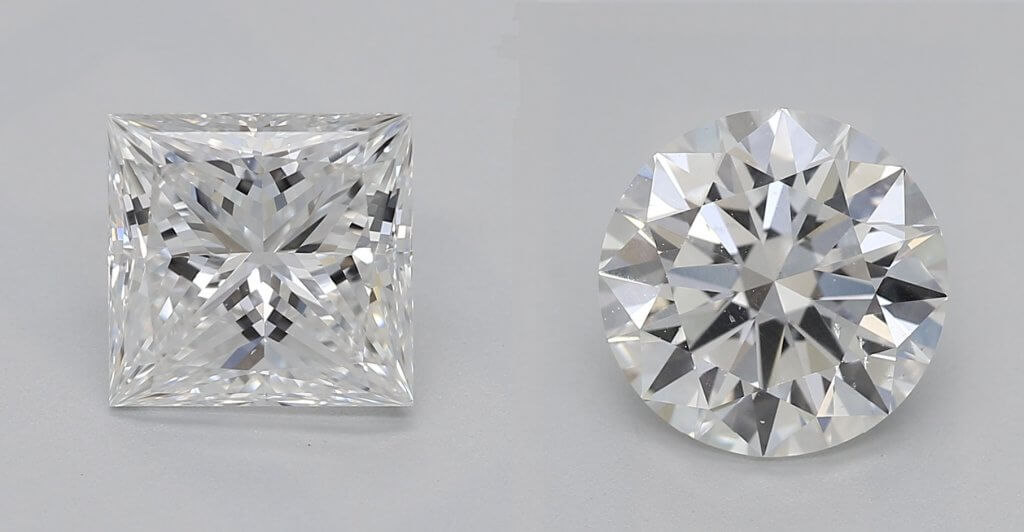
The Color and Clarity Factor
Round vs Princess Cut Diamonds: Color
When we’re talking about white (clear) diamonds, color is a negative. It’s the off-white, yellowish tint some diamonds naturally form as they grow underground, and, for obvious reasons, something that shoppers are very keen to avoid.
Generally, we recommend shoppers stick within the range of G-I on the GIA’s color scale, but I and J color diamonds (while cheaper) are only a good idea if you’re shopping for a diamond shape that can ‘handle’ a grade that low down in the Near Colorless range.
Different diamond shapes hold and show color differently. The Cushion, for instance, may produce a beautiful light display bursting with colorful fire, but the downside is that it tends to ‘hold onto’ its own color more than other shapes.
Carat also plays a part in this, since it’ll often be easier to spot traces of color in larger diamonds, but shape is a key consideration.
Luckily, both the Round and the Princess are pretty effective at masking the slight traces of color you might encounter in the G-J range, making those grades way better choices than the expensive D-F range.
Color in Round Diamonds
But, as we talked about earlier in this guide, the Round Brilliant reflects more light. Why does that matter here? Because sparkle masks color. This is why the Emerald cut can be a tricky one to get right, because the more subdued shine it offers is nowhere near as effective at preventing the eye from taking in a hint of yellow or brown.
Color in Princess Diamonds
The Princess is a major sparkler too, though, so we doubt you’d notice much of a difference between the two in terms of color. Stick to the ‘safer’ grades (i.e., the Near Colorless range of G, H, I, and J) and don’t invest until you’ve seen the diamond in person.
Round vs Princess Cut Diamonds: Clarity
As with Color, Clarity is another factor that takes on slightly different meanings for different diamond shapes. Factors like a larger, more open table – again, something exemplified by the Emerald cut – make it a lot easier for the eye to pick up on small inclusions that might otherwise have been obscured within a more complex cut.
In any case, you don’t need to invest in flawless diamonds to get flawlessness (or, at least, the appearance of flawlessness). Even shapes like the Emerald are perfectly easy to fit within a more realistic budget, provided you understand the basics of eye cleanliness.
Both the Round Brilliant and the Princess are great for offering up eye clean options, and their strong light performances will be effective at masking anything really minor.
With either shape, however, you don’t want to go for a visibly included diamond on the proviso that ‘the sparkle will cover it’. If you can see any inclusions just by looking at the diamond – from any angle – then hand it back to the jeweler and move onto the next option.
Comfort
We’ve already alluded to the Princess cut’s vulnerability, but it’s worth giving it closer attention if you really are stuck between the two.
Diamonds are incredibly strong – the strongest natural substance on earth – but that doesn’t mean that they can be cut and polished to incredibly fine points and worn on the finger day-in, day-out without some risk of breakage. Other square/rectangular shapes, like the Radiant and Emerald, have beveled corners, which makes them a lot less vulnerable.
As mentioned, it’s perfectly possible to keep a Princess diamond safe, and your partner won’t need to keep hers in a jewelry box 90% of the time just to prevent it from getting damaged. If you have a prong setting, your jeweler will recommend that those prongs are positioned at the four corners of the stone, so that the metal absorbs any bumps/knocks rather than the diamond itself.
This won’t pose a problem for everyone but, if you like the look of a floating diamond engagement ring, you may have to settle for a different diamond shape. Also, square-shaped diamonds oriented 45° on their side (so that the diagonal line follows the direction of the finger) are growing more popular, but this style is better suited to beveled shapes like the Asscher.
Provided the jeweler you work with has the skill to design a protective setting for your Princess diamond, however, wearability shouldn’t be impacted.
The Round Brilliant is very safe to wear on a day to day basis, although some settings are slightly more secure than others. A good jeweler will never send you home with a setting that poses any real risk to your diamond, however.
Our Expert Take
If you want to know which of the two shapes is the more beautiful, we might as well flip a coin. At times, we find ourselves comparing two shapes that share more similarities than differences. The same can’t be said for the Princess and the Round. From their silhouettes to the patterns created by their facets, these two shapes are at opposite ends of the spectrum.
We can’t definitively steer you in one direction or the other. If you want the ultimate in sparkle and tradition and don’t care about the premium cost, go for the Round Brilliant – it’s hard to imagine that one not going down well. If, on the other hand, your bride-to-be is chic and modern (and you don’t mind a very slight loss of sparkle for some great savings) then consider the Princess as the best option for you.
Either way, you’ll walk home with a great diamond. Just do your research, and make sure you see the diamond for yourself before making any sort of commitments.
10 FAQs
- Q: What’s the main difference in appearance between a princess cut and a round cut diamond?
A: The princess cut has sharp, angular lines with a modern look, while the round cut offers a timeless, classic appearance with maximum brilliance and fire. - Q: Is a princess cut diamond more affordable than a round cut diamond?
A: Generally, yes. Princess cut diamonds tend to be more affordable as they retain more carat weight from the original rough stone, reducing wastage during the cutting process. - Q: Which diamond cut is better for daily wear in terms of durability?
A: Round cut diamonds are typically more durable for daily wear as they don’t have sharp edges or corners that are prone to chipping, unlike the princess cut. - Q: Does a princess cut diamond look bigger than a round cut diamond of the same carat?
A: No, a princess cut diamond may appear smaller than a round cut diamond of the same carat due to differences in cut and surface area distribution. - Q: Can I choose a lower color and clarity grade for a round cut diamond without compromising its appearance?
A: Yes, round cut diamonds are effective in masking color and inclusions, allowing for a bit more leeway in choosing lower color and clarity grades. - Q: Which diamond cut is better for a contemporary engagement ring design?
A: The princess cut is ideal for those seeking a contemporary and bold look, as it offers a modern twist on traditional diamond shapes. - Q: Are round cut diamonds always more expensive than princess cut diamonds?
A: Typically, yes. Round cut diamonds are more expensive due to higher demand, popularity, and the greater wastage of raw material during the cutting process. - Q: Do princess cut diamonds require a special type of ring setting?
A: Yes, princess cut diamonds often need protective settings like prongs or bezels to safeguard their pointed corners from chipping or damage. - Q: Which cut is better for maximizing sparkle and brilliance?
A: The round cut is engineered for optimal light performance, resulting in superior brilliance and sparkle compared to the princess cut. - Q: How does the resale value compare between princess and round cut diamonds?
A: Round cut diamonds typically have a higher resale value due to their enduring popularity and universal appeal.
Discover your perfect match with Jeweler AI – where Princess Cut meets Round Brilliance. Start your journey now!
FOLLOW-UP GUIDE SERIES

